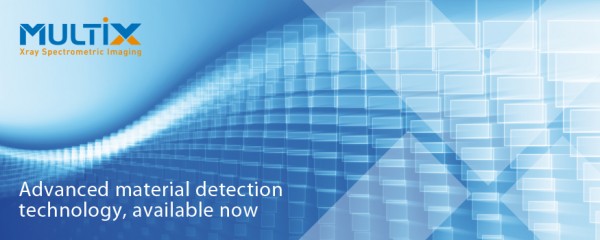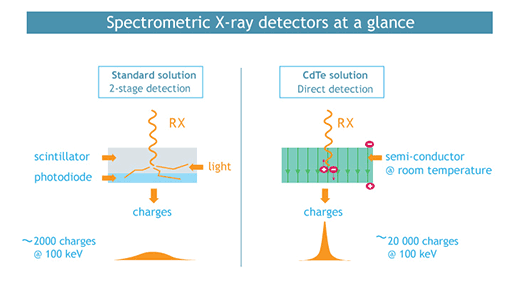
X-ray spectrometric detection to identify materials in real time.
Innovative technology
- A semiconductor crystal (CdTe/CZT) sensor operating at room temperature,
- High-speed front-end electronics capable of precisely measuring the energy of each incidental
x-ray photon, and - Powerful algorithms and high data-rate processing methods.
High-speed electronics
MultiX has designed a unique front-end electronics package that provides real time capabilities to count high photon flux and precisely measure the energy of each photon. The package also enables attenuation spectra to be reconstructed over up to 256 energy bins between 20 and 160KeV. Thanks to the high quality spectrum delivered by every pixel of the detector, each material specific x-ray signature/attenuation can be measured with significantly improved accuracy and precision giving rise to improved discrimination and identification.
Figure 1. Real time high spectrum quality under 3Mph/mm2/s with 64 energy bins from 20 to 160keV.
Current maximum counting rates range from 6 to 8 mega photon counts per second per square millimetre. This makes this technology compatible with most of the baggage scanners based on linescan x-ray imaging technology in terms of belt speeds and x-ray photon flux.
Methods and algorithms
The availability of this high quality spectrum opens new doors in terms of data processing, algorithms and methods to improve the material discrimination along with image quality.
Most current x-ray sensing technologies are only capable of roughly distinguishing between two energy bands, thereby severely reducing their ability to measure the main material discriminators (effective atomic number, Zeff) which limits the system’s ability to make a distinction between the basic classes of material: organic materials, inorganic materials and metals.
MultiX develops proprietary algorithms and methods that improve the precision and robustness of material features determination, better precision in Zeff, as well as material recovery when it comes to overlapping objects in the image.
These improvements benefit the probability of correct identification of material as depicted figure 2 in a simple case run in laboratory.
Figure 2. Relative improvement in FDR between ME-90 Energy bins(red) and DE(yellow) on a set of
single materials from CHON explosive region vs. material thickness.
Drawing on the patent portfolio of the French atomic energy commission CEA/LETI (applied research centre for microelectronics and information technologies), and proprietary patents from MultiX, the spectrometric detectors offer performance that is unrivalled in today’s market.
We are also continuing developments to further improve the identification capabilities of our multispectral detectors.

